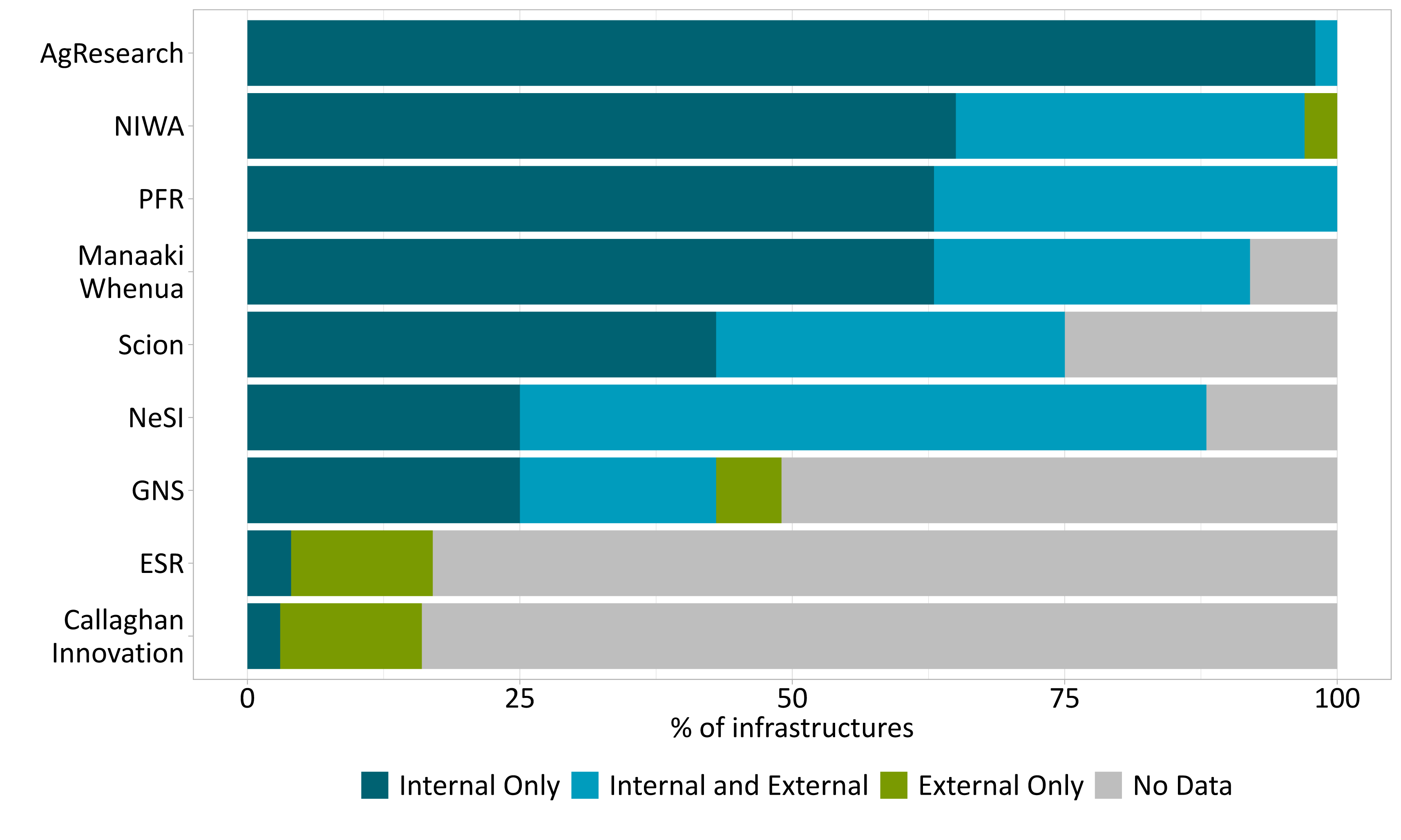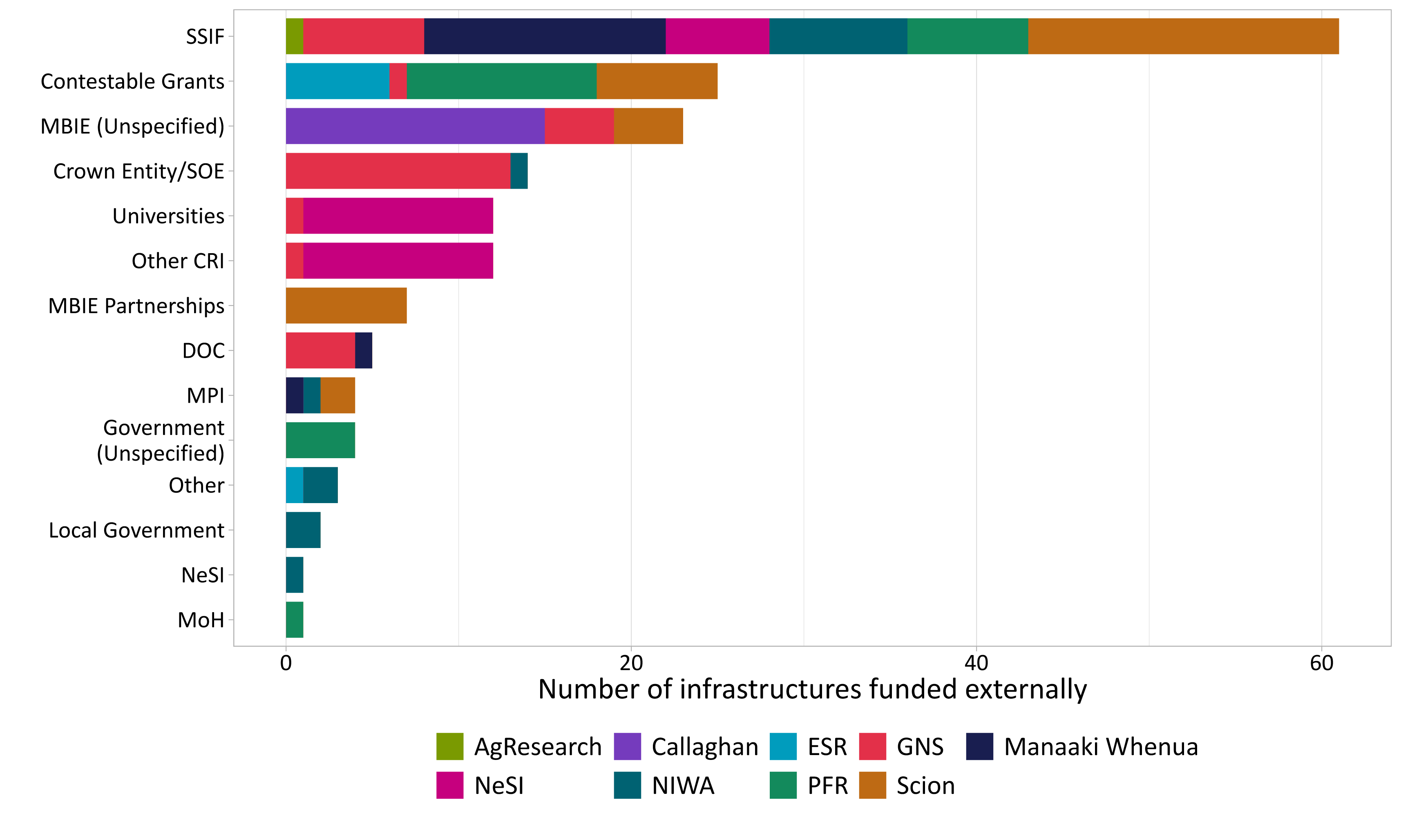Pūtea me te Whakaruruhau | Funding and governance
Funding and governance are important aspects to building the picture of research infrastructure in Aotearoa. The insights gained from the data in this section provides a key input to address the enduring questions around how research infrastructure investments should be coordinated and what constitutes effective investment mechanisms
On this page
This section covers the way in which decisions about research infrastructure are made and how it is managed across its lifetime, and the sources of funding for investments in infrastructure.
Most research infrastructures are funded by the institutions
The Kitmap survey asked institutions about how their research infrastructures are funded. Specifically, institutions were asked whether their infrastructures received external funding from grants or other sources, or if they were funded internally through overheads, commercial income, or payments for access to the infrastructures.
Figure 12: Funding sources for infrastructures at each institution*

*Data notes
Text description of figure
Metadata table (response rates)
The number of infrastructures supported by each funding source are shown in Figure 12, along with an indication of the fraction of infrastructures for which funding information was provided. We note that the responses to these questions are not mutually exclusive, as each infrastructure can receive funding from more than one source. The proportions in Figure 12 reflect only the number of infrastructures with each funding source, and not the amount of funding from each source.
As shown in Figure 12, the majority of research infrastructures from most institutions are funded internally from the institutions, with some receiving both internal and external funding. All institutions reported some level of external funding for research infrastructure, with external (direct) funding being the dominant source for ESR and Callaghan Innovation. NeSI also reported a high proportion of external funding for its research infrastructure, which is consistent with its funding as a SSIF infrastructure.
As discussed above, the institutions have different, independent approaches to infrastructure investment, which is consistent with the large proportion of funding that comes from the institution's own sources. As institutions are the primary funders of their own infrastructure, they have chief responsibility for the governance and investment decisions around it. While there are instances in the data of infrastructures being co-funded between institutions or with private companies or universities, these were rare and do not make up a significant portion of the infrastructures.
The Strategic Science Investment Fund is an important means of supporting research infrastructure
For those infrastructures where external funding was reported, the sources of that funding are broken down in Figure 13. This figure represents the 22% of total infrastructures in the survey that were designated as receiving external funding.[12]
Figure 13: Number of infrastructures linked to each external funding sources in the Kitmap data*

*Data notes
Text description of figure
Metadata table (response rates)
SSIF funding was the primary source of external funding by a significant margin (Figure 13). This is consistent with the CRIs and NeSI receiving funding as SSIF programmes and SSIF infrastructures respectively (we note that these 2 instruments are not distinguished in the data). As a Crown agent, Callaghan Innovation is predominantly funded through its own appropriations, which are (partially) represented in the ‘MBIE (unspecified)’ bar on Figure 13. ESR did not report SSIF funding, which may reflect incomplete data, although it may be the case that ESR’s SSIF funding does not directly fund any of its infrastructure.
Contestable grants feature prominently in the data as a source of external funding for infrastructure reported by the institutions, with 4 institutions reporting significant proportions from this source. However, information on the specific funding instruments was not provided.
A number of Crown Entities or State-Owned Enterprises (SOE) were represented in the external funding sources. These organisations included Antarctica NZ, the Earthquake Commission, Land Information New Zealand (LINZ), and MetService. Several institutions reported direct funding from government Ministries beyond MBIE, including Ministry for Primary Industries (MPI), Department of Conservation (DOC) and Ministry of Health (MOH), which relates to the proportion in which these Ministries featured as users of research infrastructure from the institutions (Figure 11). MBIE is the largest funder of research infrastructure (through the SSIF fund and grants; Figure 13), although a number of other government ministries feature more prominently in the data on users (Figure 10).
Institutions lead decisions around infrastructure
The institutions reported on their respective approaches to governance and funding of research infrastructures through a free text field in the Kitmap survey. The CRIs all described similar governance processes to approach decisions pertaining to research infrastructure investments. These processes appear to exist in relation to not only initial investment in research infrastructures, but also for renewal, upgrade, and replacement.
Broadly, the size of each prospective investment determines the approach taken by institutions. That is, large research infrastructure investments over a certain dollar amount will be subject to a different process than smaller investments under that amount. Aspects of the decision-making process reported by the institutions included businesses cases (always for high value infrastructures), asset management planning, lifecycle evaluation, justification of investment to meet current and future science needs, consideration of duplication of infrastructure elsewhere in Aotearoa, and opportunities to consider partnerships as opposed to investing themselves. Final approval occurs at different governance levels depending on size of investment, with large investment decisions being made at the board level, while some investment decisions are made at lower organisational levels when below a defined dollar amount. There may also be differences in processes for considering investment in, for example, equipment versus a building or land, linked to requirements from Treasury for the institutions in preparing their business cases for these investments.
This approach of the institutions both initiating, investing in, and governing their own research infrastructures is established by the SSIF framework, which is a major source of funding for all of the institutions except Callaghan Innovation. The role of SSIF is to fund strategic investment in research programmes and scientific infrastructure that have long-term beneficial impacts on New Zealand’s health, economy, environment, and society[13]. The SSIF Investment Plan outlines that
“the bulk of infrastructure investments are made by research organisations, paid for as part of the regular costs of conducting research. The SSIF supports the few infrastructure projects that have high national benefits that will not emerge in the course of usual business because of the public nature of the benefits, and the scale, complexity, long duration and multi-user nature of the investment.”[14]
Some of the institutions reported that they undertake internal CAPEX processes on an annual basis, through which all proposals for research infrastructure purchases are considered for approval through a common governance process.
NeSI has a different institutional structure to the CRIs, and thus a more unique approach to governance and funding of research infrastructure. It operates on a governance model of investment based on co-design and joint investment across the contributing institutions. NeSI reported that its approach builds a common view of user needs across institutions and research communities nationally, which is informed by capacity management and demand. Through this framework, review of current and future infrastructure is supported every 2 years for major investments, and annually for incremental management of capacity.
While these examples share similarities with international approaches to governance and funding of research infrastructure, there are also important differences. Internationally, research infrastructure road-mapping exercises are a common approach for national coordination, providing planning and strategic priorities for research infrastructure investment, typically for 5-10 years in the future. As Aotearoa does not have such a national planning mechanism or other central coordination for research infrastructure investment, our institutions make investment decisions on an individual basis, with large national infrastructures decisions occurring at a government level on a case-by-case, ad hoc, basis.
[12] The data here do not distinguish between different categories of SSIF funding (such as SSIF Programmes or SSIF Infrastructure). We note that while SSIF Infrastructure provides the highest amount of funding, relatively few infrastructures are directly supported through that instrument.
[13] Strategic Science Investment Fund
[14] Strategic Science Investment Fund: Investment Plan 2017 - 2024 [PDF, 794 KB]

